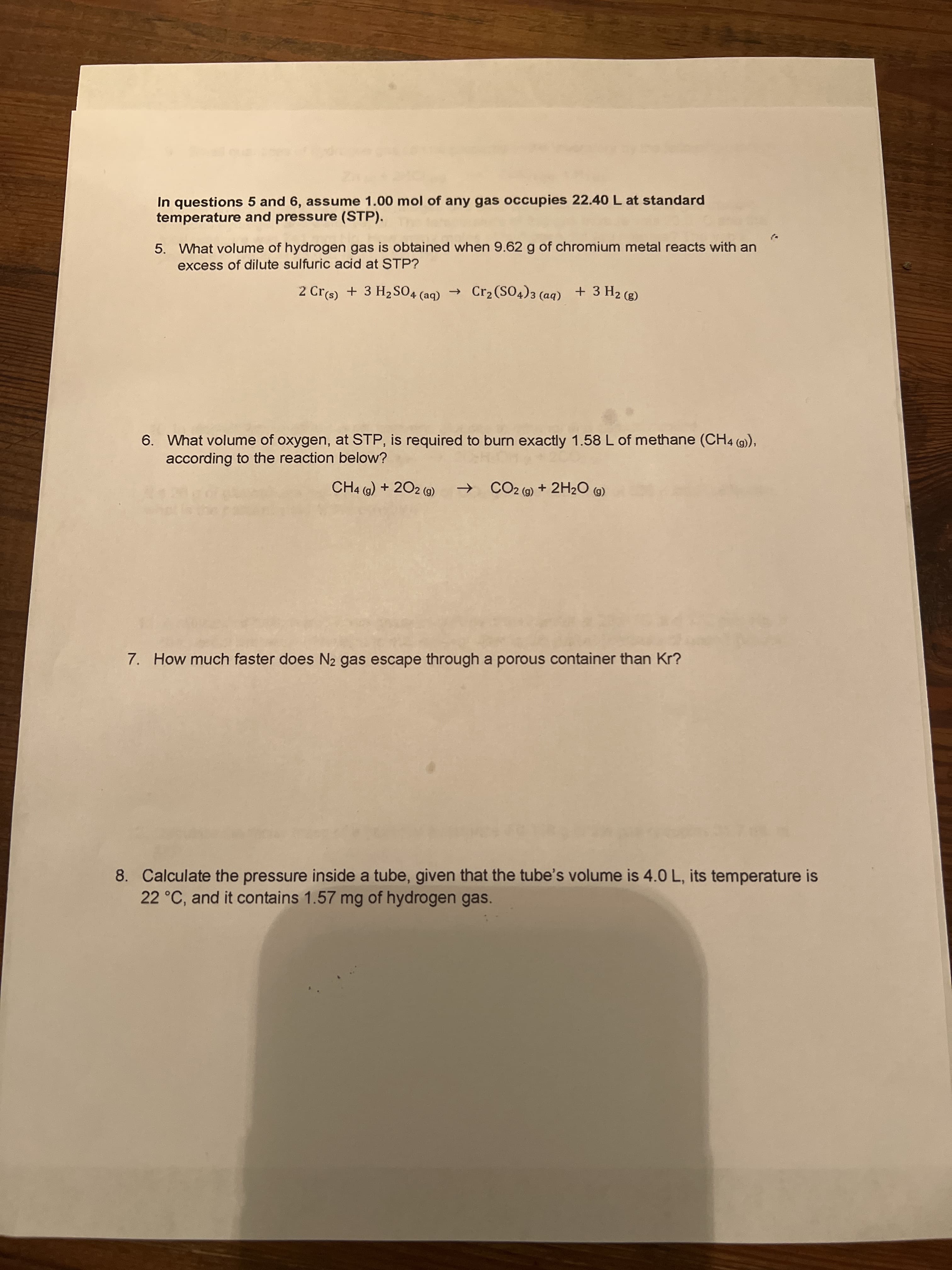In questions 5 and 6, assume 1.00 mol of any gas occupies 22.40 L at standard temperature and pressure (STP). 5. What volume of hydrogen gas is obtained when 9.62 g of chromium metal reacts with an excess of dilute sulfuric acid at STP? 2 Crs) + 3 H2 SO4 (aq) Cr2 (SO4)3 (aq) + 3 H2 (g) 6. What volume of oxygen, at STP, is required to burn exactly 1.58 L of methane (CH4 (9), according to the reaction below? CH4 (g) + 202 (g) CO2 (9) + 2H2O (9)
In questions 5 and 6, assume 1.00 mol of any gas occupies 22.40 L at standard temperature and pressure (STP). 5. What volume of hydrogen gas is obtained when 9.62 g of chromium metal reacts with an excess of dilute sulfuric acid at STP? 2 Crs) + 3 H2 SO4 (aq) Cr2 (SO4)3 (aq) + 3 H2 (g) 6. What volume of oxygen, at STP, is required to burn exactly 1.58 L of methane (CH4 (9), according to the reaction below? CH4 (g) + 202 (g) CO2 (9) + 2H2O (9)
Chemistry for Engineering Students
4th Edition
ISBN:9781337398909
Author:Lawrence S. Brown, Tom Holme
Publisher:Lawrence S. Brown, Tom Holme
Chapter5: Gases
Section: Chapter Questions
Problem 5.106PAE
Related questions
Question
100%
5 & 6 go together.

Transcribed Image Text:In questions 5 and 6, assume 1.00 mol of any gas occupies 22.40 L at standard
temperature and pressure (STP).
5. What volume of hydrogen gas is obtained when 9.62 g of chromium metal reacts with an
excess of dilute sulfuric acid at STP?
2 Crs) + 3 H2SO4 (aq)
→ Cr2(SO4)3 (aq) + 3 H2 (g)
6. What volume of oxygen, at STP, is required to burn exactly 1.58 L of methane (CH4 (9),
according to the reaction below?
CH4 (9) + 202 (9)
CO2 (9) + 2H2O (G)
(6)
7. How much faster does N2 gas escape through a porous container than Kr?
8. Calculate the pressure inside a tube, given that the tube's volume is 4.0 L, its temperature is
22 °C, and it contains 1.57 mg of hydrogen gas.
Expert Solution
This question has been solved!
Explore an expertly crafted, step-by-step solution for a thorough understanding of key concepts.
This is a popular solution!
Trending now
This is a popular solution!
Step by step
Solved in 2 steps with 1 images

Knowledge Booster
Learn more about
Need a deep-dive on the concept behind this application? Look no further. Learn more about this topic, chemistry and related others by exploring similar questions and additional content below.Recommended textbooks for you

Chemistry for Engineering Students
Chemistry
ISBN:
9781337398909
Author:
Lawrence S. Brown, Tom Holme
Publisher:
Cengage Learning

Chemistry: An Atoms First Approach
Chemistry
ISBN:
9781305079243
Author:
Steven S. Zumdahl, Susan A. Zumdahl
Publisher:
Cengage Learning


Chemistry for Engineering Students
Chemistry
ISBN:
9781337398909
Author:
Lawrence S. Brown, Tom Holme
Publisher:
Cengage Learning

Chemistry: An Atoms First Approach
Chemistry
ISBN:
9781305079243
Author:
Steven S. Zumdahl, Susan A. Zumdahl
Publisher:
Cengage Learning


Introductory Chemistry: A Foundation
Chemistry
ISBN:
9781337399425
Author:
Steven S. Zumdahl, Donald J. DeCoste
Publisher:
Cengage Learning

Chemistry & Chemical Reactivity
Chemistry
ISBN:
9781337399074
Author:
John C. Kotz, Paul M. Treichel, John Townsend, David Treichel
Publisher:
Cengage Learning

Chemistry & Chemical Reactivity
Chemistry
ISBN:
9781133949640
Author:
John C. Kotz, Paul M. Treichel, John Townsend, David Treichel
Publisher:
Cengage Learning